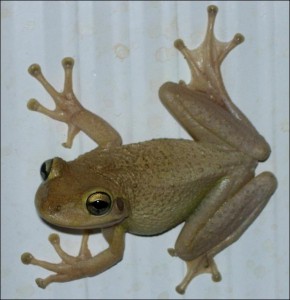As we come to the end of National Invasive Species Awareness Week (NISAW), I need to educate everyone on a potential invasive threat, a classic Early Detection Rapid Response (EDRR) species – the Cuban Treefrog.

is this a Cuban Tree Frog? Do I have to rely on DNA barconding to know for sure – before I decide to euthanize it? Could I be making a mistake?
Image by Dr. Steve A Johnson 2005.
This treefrog was first introduced into to south Florida in the 1920’s. Like lionfish, it quickly became established and began its slow dispersal northward. It is a large predatory frog (reaching about 5”) which began to consume native treefrogs, reducing their populations wherever they were found. In addition to consuming native frogs, Cuban Treefrogs eat snails, millipedes, spiders, and many other small creatures. They can produce a call that is somewhat annoying to many residents where it is found. It is currently listed as established as far north as Gainesville FL.
A few years ago, I received a call from a resident near Big Lagoon in southwest Escambia County. They had just purchased plants from a local chain store to plant in their yard the following day. They had left the plants on the front porch that night and, at some point, noticed this large treefrog on their front door. They wanted to know if this was a non-native frog. It was – it was the Cuban Treefrog. The animal was collected and sent to the University of Florida.
This is a common method of transporting this frog north. They attach to ornamental plants grown in nurseries in south Florida. The plants are loaded on trucks and shipped to the panhandle and locations north and west. There are probably numerous species hitching rides this way, including the Cuban Anole (an invasive lizard). Lucky for us, in many cases these tropical problem species cannot tolerate our cold winters – this could also be said for some of the invasive plants. However, in recent years, the winters have been milder and some of these species are surviving. Most of us know and understand the impact lionfish have had on local small reef fish; no one is interested in another “lionfish problem” in the panhandle.
About a year ago, a second Cuban Treefrog was reported in Crestview.
Early this year I attended an amphibian/reptile conference in north Georgia. There was a presentation given by a scientist from the U.S. Geological Survey in Lafayette LA. He had a call from the Audubon Zoo in New Orleans about a strange frog they had been finding. They had recently purchased palm trees from south Florida for the elephant exhibit. The caretakers of the exhibit began to see strange frogs and reported it. When USGS arrived, they meandered through the park searching. They stopped by the public bathroom to look (a place I have found them in south Florida myself). They happen to pass an electric panel outside the restroom and decided to take a peak – 13 Cuban Treefrogs were within.
They began an exhaustive search and found CTFs everywhere. Most had moved into a public park between the zoo and the river called Riverview. I cannot remember how many they had found but it was in the hundreds, the animals were beginning to establish themselves in this area of New Orleans. USGS is currently working on the problem.
Just a few weeks ago, a Cuban Treefrog was found on Davenport Bayou off Bayou Grande.
There are many reports of single, individual CTFs across the northern Gulf coast, but none were established populations. However, as reports increase we should be looking for these animals and try to keep them under control before they do. No more “lionfish problems”.
How do we do this?
The following link provides information about the frog, how to identify it, how to set traps to determine if the animal is in your neighborhood, and what to do if you do find one. I would include reporting the finding on www.EDDMapS.org. I also recommend as you purchase plants for this spring’s landscaping projects, check the plants carefully for any hitchhikers. This “early detection” method is the most effective way to battle the movement of invasive species.
If you have questions about Cuban Treefrogs, let me know.
Johnson, S.A. 2017. The Cuban Treefrog (Osteopilus septentrionalis) in Florida. University of Florida Extension Electronic Data Information Source (EDIS) document WEC218.
http://edis.ifas.ufl.edu/uw259.
- Rattlesnakes on Our Barrier Islands; Part 3 – Envenomation - December 22, 2025
- St. Joe Red Tide Claiming Terrapins - December 15, 2025
- The 2025 Snake Watch Report for the Pensacola Bay Area - December 15, 2025
